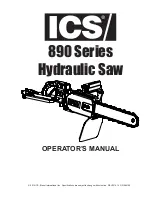
EN
5
Special safety instructions
1)
Keep all parts of the body away from the saw chain when the chain saw is operating. Before
you start the chain saw, make sure the saw chain is not contacting anything. A moment of
inattention while operating chain saws may cause entanglement of your clothing or body with
the saw chain.
2)
Always hold the chain saw with your right hand on the rear handle and your left hand on the
front handle. Holding the chain saw with a reversed hand configuration increases the risk of
personal injury and should never be done.
3)
Wear safety glasses and hearing protection. Further protective equipment for head, hands,
legs and feet is recommended. Adequate protective clothing will reduce personal injury by
flying debris or accidental contact with the saw chain.
4)
Do not operate a chain saw in a tree. Operation of a chain saw while up in a tree may result in
personal injury.
5)
Always keep proper footing and operate the chain saw only when standing on fixed, secure
and level surface. Slippery or unstable surfaces such as ladders may cause a loss of balance or
control of the chain saw.
6)
When cutting a limb that is under tension be alert for spring back. When the tension in the
wood fibres is released the spring loaded limb may strike the operator and/or throw the chain
saw out of control.
7)
Use extreme caution when cutting brush and saplings. The slender material may catch the
saw chain and be whipped toward you or pull you off balance.
8)
Carry the chain saw by the front handle with the chain saw switched off and away from your
body. When transporting or storing the chain saw always fit the guide bar cover. Proper
handling of the chain saw will reduce the likelihood of accidental contact with the moving saw
chain.
9)
Follow instructions for lubricating, chain tensioning and changing accessories. Improperly
tensioned or lubricated chain may either break or increase the chance for kickback.
10)
Keep handles dry, clean, and free from oil and grease. Greasy, oily handles are slippery
causing loss of control.
11)
Cut wood only. Do not use chain saw for purposes not intended. For example: do not use
chain saw for cutting plastic, masonry or non-wood building materials. Use of the chain saw
for operations different than intended could result in a hazardous situation.
12)
Maintain a firm grip, with thumbs and fingers encircling the chain saw handles, with both
hands on the saw and position your body and arm to allow you to resist kickback forces.
Kickback forces can be controlled by the operator, if proper precautions are taken. Do not let
go of the chain saw.
13)
Do not overreach and do not cut above shoulder height. This helps prevent unintended tip
contact and enables better control of the chain saw in unexpected situations.
14)
Only use replacement bars and chains specified by the manufacturer. Incorrect replacement
bars and chains may cause chain breakage and/or kickback.
15)
Follow the manufacturer’s sharpening and maintenance instructions for the saw chain.
Decreasing the depth gauge height can lead to increased kickback.
16)
Two hands must be used in operation of chain saw.
17)
Cut the wood in right direction.
18)
Make sure that the voltage on the rating plate is the same as your supply system. Only then
are you to insert the power plug in the mains socket outlet.
19)
Wear eye protection, ear protection and gloves.
20)
Before using the chain saw, be sure to check the chain and bar in tension. Don’t use the chain
saw if the chain and bar are loose. Also confirm that no abnormality exists by actual test
running.





































